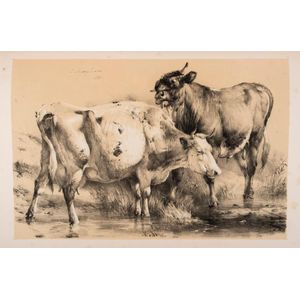Cooper's Cattle: 26 Tinted Lithographic Plates
This site contains only a limited number of works of art sold in Australia and New Zealand, and is not representative of the art market for any artist. For a comprehensive art database visit our specialist site, Australian Art Sales Digest which includes over 400,000 works auctioned in Australia and New Zealand by over 30,000 artists, covering the period from the early 1970s to the present day.
Thomas Sidney Cooper, groups of cattle, drawn from nature, [London : Ackermann & Co.], 1839 first edition. Elephant folio, handsomely bound in contemporary half red morocco over marbled boards with five raised bands to the spine, compartments decorated in gilt and titles in gilt. Page edges gilt; marbled end papers. With 26 tinted lithographic plates (including the title page).
You must be a subscriber, and be logged in to view price and dealer details.
Subscribe Now to view actual auction price for this item
When you subscribe, you have the option of setting the currency in which to display prices to $Au, $US, $NZ or Stg.
This item has been sold, and the description, image and price are for reference purposes only.
- Ackermann, Rudolph - Rudolph Ackermann (1764 - 1834) was born in Saxony and is best known as a publisher of decorative coloured prints in London.
His early career demonstrated an entrepreneurial bent that was to lead to his success as a businessman in London.
At the age of 15 he was apprenticed to a saddler, and three years later moved to Dresden to train as a (horse-driven) carriage designer.
He later lived in Switzerland, France and Belgium for short periods, before moving to London in 1787.
He set up a successful business as a coach designer and decorator and in 1795 diversified his interest to include publishing and bookselling. His first decorative hand-coloured prints appeared in 1797. His output included political and social caricatures by leading artists of the day.
From 1809-1829 he published "Ackermann's Repository of Arts", an illustrated annual British periodical which covered arts, literature, commerce, manufactures, fashions, and politics, and had great influence on English taste in fashion, architecture, and literature.
His most ambitious venture was "The Microcosm of London". Which was completed in 1810 in collaboration with leading artists of the day, and contained 104 large folio hand-coloured aquatints.
In the following years he published further volumes, again working with artists such as William Pyne, established branches of his business in several Central and South American cities, and set up a publishing business for his son, also called Rudolph, one of his nine children in Regent Street, London. This business was taken over by Rudolph Junior's son Arthur, and was later renamed Arthur Ackermann Ltd. and was trading as fine art dealers until 2011.
His death in 1834 was preceded by a stroke in 1833 which left him partly paralysed. - Marbling - A descriptive term for a finish applied to plastic, ceramics, glass, plaster or wood to imitate the colours and characteristic markings of various marble types. For moulded items such as the first three above, the marbling is within the item.
Interiors and furniture were marbled from from the early 17th century to the late Victorian period. The craft was practiced by skilled decorators using a combination of brushes and sponges. Some of the finishes achieved were so realistic as to make it difficult to distinguish the marbled surface from the marble surface.
Marbling is also a term applied to a finish for paper as often seen in the front and endpapers of old books. The marbling is achieved by floating the colours on water and then transferring them to paper. However the marbling finish on paper, as with the marbling finish on plastics, with its multitude of colours has little resemblance to naturally occurring marble.
This item has been included into following indexes:
